Postcards from a Pandemic
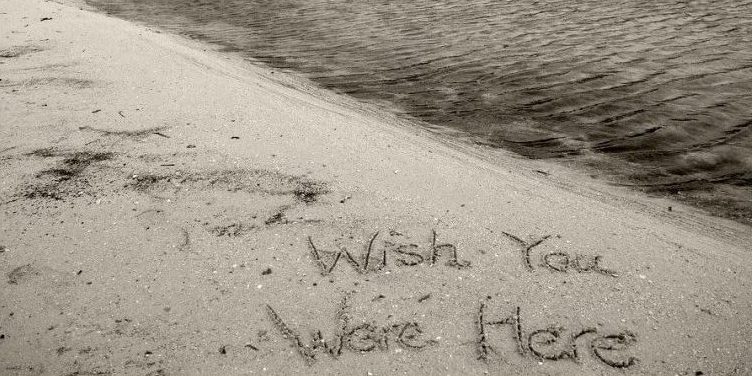
This article follows a presentation to the Royal Society of Victoria on 9 July 2020 titled “Imagine a World – Postcards from a Pandemic” delivered by Professor Julie Arblaster (School of Earth, Atmosphere and Environment at Monash University), Dr Colleen Boyle (RMIT School of Design), Dr Jenny Gray (Zoos Victoria), Professor Rachel Webster (University of Melbourne School of Physics), and moderated by Alicia Sometimes.
When we write postcards, we take time to stop and reflect. What messages would we send to our future selves? When we finally emerge from our homes following lockdown, what sort of world do we want to live in?
Powerful images and messages can ignite change. A multi-disciplinary panel of experts reflected on the 50th anniversary of Earthrise in 2018 – the first photo of Earth captured from space that sparked an environmental movement. The panel gathered again to discuss what they see as inspirational for scientists, governments and communities to take action in response to COVID-19, devastating bushfires, and systemic racism and social unrest.
So far, 2020 brought along many circumstances outside of our control, described by writer Alicia Sometimes in three poetic postcards:
Before the pandemic we were amongst the unbridled fires, lush landscapes were blistering, and communities came together to offer donations and support to rebuild towns that were destroyed. During the pandemic and in lockdown we feel as if we’re in a snow dome. Gaps in wealth, age, sex, age and disability became highlighted and people marched forcefully with thunder in response to social injustice. Once we emerge, Alicia hopes to see people sitting in parks, giving the earth an ECG and measuring the rise in biodiversity. She also hopes that we have better communication with scientists; that we are vigorous in our change and carve out a new equilibrium[1].
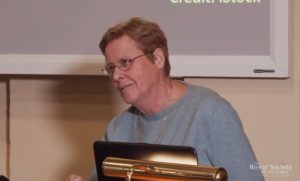 To astrophysicist, Professor Rachel Webster, ‘nothing can fill us as completely as the night sky’. During this time, she has been looking outwards into space at supernovae – the powerful and luminous explosions of stars that briefly outshine entire galaxies and the Moon. They make her see that ‘the Universe will proceed on its course with or without us’. As Rachel felt the world shrink and become constrained due to COVID-19 lockdown measures, images of deep space lifted her out there and puts herself in the big picture. She worries that sometimes we lose the big picture and forget our context in the cosmos. But there is no escaping reality: we are essentially ‘creatures of the Universe’, comprised of atoms and star dust, and are therefore ultimately ruled by nature but we can choose how we interact with it.
To astrophysicist, Professor Rachel Webster, ‘nothing can fill us as completely as the night sky’. During this time, she has been looking outwards into space at supernovae – the powerful and luminous explosions of stars that briefly outshine entire galaxies and the Moon. They make her see that ‘the Universe will proceed on its course with or without us’. As Rachel felt the world shrink and become constrained due to COVID-19 lockdown measures, images of deep space lifted her out there and puts herself in the big picture. She worries that sometimes we lose the big picture and forget our context in the cosmos. But there is no escaping reality: we are essentially ‘creatures of the Universe’, comprised of atoms and star dust, and are therefore ultimately ruled by nature but we can choose how we interact with it.
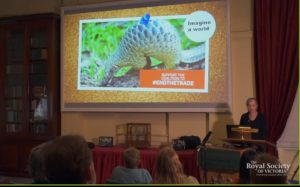 Dr Jenny Gray, CEO of Zoos Victoria, pondered the postcards and messages we would receive from animals during this time. At the beginning of the lockdown, the quietness in nature and public spaces was deafening. But that space was soon filled with birdsong and animal calls as animals started to emerge during the day – tentatively at first, and then more boldly. Foxes came out in Royal Park in broad daylight, butterflies did not have to fly as high, and the penguins at St Kilda pier even waddled on the boardwalks with the beaches clear of people. Jenny is concerned that we push other animals out of the way as we grow in number and they simply cannot compete. For a few months, we saw what the world might be like if we retreated. We do not have to stay indoors, but Jenny is hopeful that we can learn to respect the space of animals more. Unfortunately, not all me
Dr Jenny Gray, CEO of Zoos Victoria, pondered the postcards and messages we would receive from animals during this time. At the beginning of the lockdown, the quietness in nature and public spaces was deafening. But that space was soon filled with birdsong and animal calls as animals started to emerge during the day – tentatively at first, and then more boldly. Foxes came out in Royal Park in broad daylight, butterflies did not have to fly as high, and the penguins at St Kilda pier even waddled on the boardwalks with the beaches clear of people. Jenny is concerned that we push other animals out of the way as we grow in number and they simply cannot compete. For a few months, we saw what the world might be like if we retreated. We do not have to stay indoors, but Jenny is hopeful that we can learn to respect the space of animals more. Unfortunately, not all me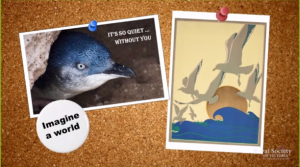 ssages from animals during this time contain good news. Some natural parks rely on tourism for funds to protect wildlife (e.g. protecting rhinos from poachers), and the economic burden of the pandemic discourages small farmers and other stakeholders to contribute to expanding the sustainable palm oil industry. The lockdown highlighted how little space and resources we need, and Jenny hopes that we will be able to better share our planet with animals once we re-emerge.
ssages from animals during this time contain good news. Some natural parks rely on tourism for funds to protect wildlife (e.g. protecting rhinos from poachers), and the economic burden of the pandemic discourages small farmers and other stakeholders to contribute to expanding the sustainable palm oil industry. The lockdown highlighted how little space and resources we need, and Jenny hopes that we will be able to better share our planet with animals once we re-emerge.
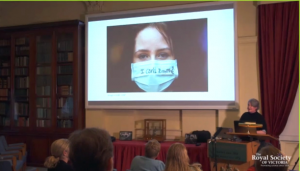
Artist Dr Colleen Boyle reflected on images taken within the past six months that encourage us to question our values. The first questions our liberties: it was the image of a closed beach with people being asked to leave. With each restriction or measure implemented, such as the closure of public places, travel limits, and now mandatory face masks, some regard this as an attack on our civil liberties. But these laws are being enforced for our own good. The second image was of people fighting over toilet paper and emptying supermarket aisles. It questions our ethics – are we doing the right thing by others in our ‘selfish drive to survive despite all others’? The “panic buying” crazemade it difficult for people to source supplies; one person stocking up could deprive others of what they need. The last was an image of a sign: “I can’t breathe”. When George Floyd was killed in Minneapolis in May, the world exploded in anger. While the Black Lives Matter campaign has a long, traumatic history, somehow, responding to a new respiratory disease made us more aware that we are all merely ‘skin, bones, sweat, and blood’. Colleen imagines a world with more balance and equality, and greater consideration of others.
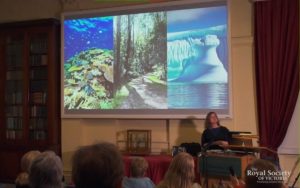 Climate scientist, Professor Julie Arblaster, reflected on the invisible global challenges we face. SARS-CoV-2 is a virus that causes devastation, but we cannot see coming, just like the rising greenhouse gas levels in the atmosphere, sea levels, and global temperature. Greenhouse gas emissions is another curve that climate scientists aim to flatten. Climate prediction and greenhouse gas emission models are not just in the hands of climate scientists, but also take the human population into account – demography, economics, technology, and our actions – providing multiple possible futures based on these variables. Julie hopes for a low emissions scenario. No matter which outcome we see, the planet will warm by at least 2°C, but we can choose our future and determine the extent of warming. Already during the pandemic, there has been a 7% reduction in carbon emissions, and if we sustain this reduction for decades to come, there is hope. The pandemic showed that it is possible to band together and make decisions based on science. Government policies rapidly adapted to guidance from the World Health Organization to flatten the curve of COVID-19 cases. Governments and communities need to work together to see environmental change and action against climate change – and it clearly can be done.
Climate scientist, Professor Julie Arblaster, reflected on the invisible global challenges we face. SARS-CoV-2 is a virus that causes devastation, but we cannot see coming, just like the rising greenhouse gas levels in the atmosphere, sea levels, and global temperature. Greenhouse gas emissions is another curve that climate scientists aim to flatten. Climate prediction and greenhouse gas emission models are not just in the hands of climate scientists, but also take the human population into account – demography, economics, technology, and our actions – providing multiple possible futures based on these variables. Julie hopes for a low emissions scenario. No matter which outcome we see, the planet will warm by at least 2°C, but we can choose our future and determine the extent of warming. Already during the pandemic, there has been a 7% reduction in carbon emissions, and if we sustain this reduction for decades to come, there is hope. The pandemic showed that it is possible to band together and make decisions based on science. Government policies rapidly adapted to guidance from the World Health Organization to flatten the curve of COVID-19 cases. Governments and communities need to work together to see environmental change and action against climate change – and it clearly can be done.
What have the past six months shown us? The fact that there is hope. That images and science can work together to create change. We can make the world a better place for ourselves, our animals, and our environment. As we get through the pandemic, Alicia, Rachel, Jenny, Colleen and Julie write from the world they envision for the future and say: wish you were here.
[1] This paragraph paraphrases Alicia’s poems using her eloquent phrases.
Catriona Nguyen-Robertson, MRSV
